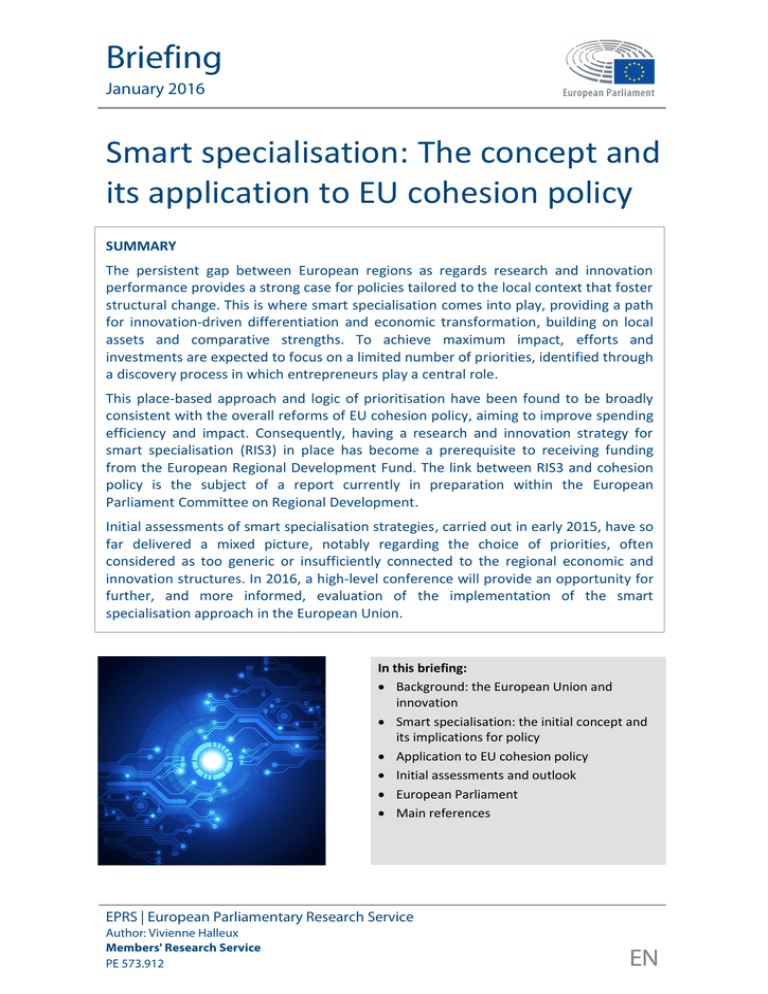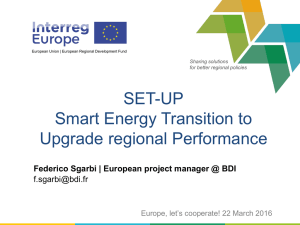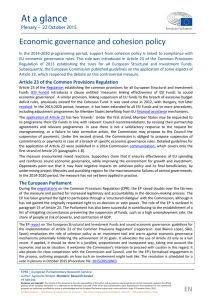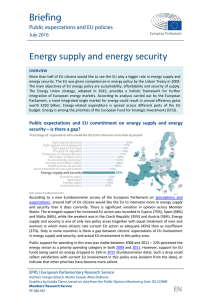Smart specialisation - European Parliament
Anuncio

Briefing January 2016 Smart specialisation: The concept and its application to EU cohesion policy SUMMARY The persistent gap between European regions as regards research and innovation performance provides a strong case for policies tailored to the local context that foster structural change. This is where smart specialisation comes into play, providing a path for innovation-driven differentiation and economic transformation, building on local assets and comparative strengths. To achieve maximum impact, efforts and investments are expected to focus on a limited number of priorities, identified through a discovery process in which entrepreneurs play a central role. This place-based approach and logic of prioritisation have been found to be broadly consistent with the overall reforms of EU cohesion policy, aiming to improve spending efficiency and impact. Consequently, having a research and innovation strategy for smart specialisation (RIS3) in place has become a prerequisite to receiving funding from the European Regional Development Fund. The link between RIS3 and cohesion policy is the subject of a report currently in preparation within the European Parliament Committee on Regional Development. Initial assessments of smart specialisation strategies, carried out in early 2015, have so far delivered a mixed picture, notably regarding the choice of priorities, often considered as too generic or insufficiently connected to the regional economic and innovation structures. In 2016, a high-level conference will provide an opportunity for further, and more informed, evaluation of the implementation of the smart specialisation approach in the European Union. In this briefing: Background: the European Union and innovation Smart specialisation: the initial concept and its implications for policy Application to EU cohesion policy Initial assessments and outlook European Parliament Main references EPRS | European Parliamentary Research Service Author: Vivienne Halleux Members' Research Service PE 573.912 EN Smart specialisation EPRS Background: the European Union and innovation Policy context Macroeconomic research over the last decades has shown that innovation drives up to 80% of economic growth in developed countries. In view of its essential role in ensuring the European Union (EU)'s economic performance and competitiveness at global level, as well as its ability to create jobs and address societal issues such as climate change, energy and food security, health and an ageing population, innovation has been placed at the core of Europe 2020, the EU's strategy for smart, sustainable and inclusive growth, with the Innovation Union flagship initiative. Designed as an action plan, it aims to boost the EU's capacity to innovate, in particular by addressing the main obstacles to innovation (insufficient availability of finance, market fragmentation, expensive patenting, slow standard-setting, skills shortages) and by pooling efforts between innovation cycle actors, notably through Innovation Partnerships. With the Europe 2020 strategy, the EU has set itself a concrete objective of raising investment in R&D (research and development, a major driver of innovation) to 3%1 of its GDP by 2020. Achieving this target is expected to create 3.7 million jobs and increase the EU's annual GDP by €795 billion by 2025. The Innovation Union is implemented through the Horizon 2020 financial instrument. With a current budget of €74.8 billion2 over seven years (2014-2020), it is the largest EU programme3 supporting research and innovation activities. Funding is allocated through competitive calls for proposals, centrally managed by the European Commission. Current innovation landscape The European Union is confronted with persistent innovation gaps, both internationally and internally. The latest edition of the Innovation Union Scoreboard,4 which provides, on the basis of a set of 25 different indicators (including R&D expenditure, educational standards, patent production and business innovation), a comparative assessment of the research and innovation performance of EU Member States and several non-EU countries, indicates that at global level, the Union is still lagging behind its main competitors. It confirms the performance lead of South Korea, the USA and Japan over the EU. With an average annual innovation growth of 3.6% (compared to 2.4% for the European Union), China is catching up quickly. Figure 1 – EU Member States' innovation performance At EU level, performance differences between Member States are still relatively high. Sweden has the best performing innovation system, followed by Denmark, Finland and Germany (see figure 1). They all belong to the group of 'innovation leaders'. Data source: Innovation Union Scoreboard, 2015. Depending on how close their performance is to that of EU average, other Member States are respectively classified in the categories of 'innovation followers' (above/close to average), 'moderate' (below) or 'modest innovators' (well below). Members' Research Service Page 2 of 10 EPRS Smart specialisation According to the latest data from Eurostat, EU Member States spent a total of around €283 billion on research and development in 2014. With 2.03%, the R&D intensity, i.e. R&D expenditure as a percentage of GDP, remained stable compared to 2013. With respect to main global competitors, R&D intensity in the EU was significantly lower than in South Korea (4.15% in 2013) and Japan (3.47% in 2013), lower than in the USA (2.81% in 2012), and about the same level as in China (2.08% in 2013). Within the EU, in 2014, the highest R&D intensities were registered in Finland (3.17%), Sweden (3.16%) and Denmark (3.08%), followed by Austria (2.99%) and Germany (2.84%). In contrast, the lowest percentage was recorded in Romania (0.38%). At regional level, the geography of innovation is also very diverse. The Regional Innovation Scoreboard 20145 showed that innovation excellence remains concentrated in a relatively small number of regions across the EU. The report identified 27 EU regions as innovation leaders, located in only eight Member States: Denmark, Germany, Ireland, France, the Netherlands, Finland, Sweden and the United Kingdom (see map 1). Although regional performance varies within countries, regional performance groups appear to match6 quite well to the corresponding national performance groups. Map 1 – Regional innovation performance groups Data source: European Commission, Regional Innovation Scoreboard 2014 According to the Eurostat regional yearbook 2015, one in ten (10.5%) of the 266 NUTS level 27 regions for which data are available reported R&D intensity that had reached the 3% target. Together, these regions accounted for over one third of the EU28's total R&D expenditure in 2012. Unsurprisingly, many German and Nordic regions were among those recording high or above average R&D intensity. Members' Research Service Page 3 of 10 EPRS Smart specialisation This persistent gap between European regions as regards research and innovation performance thus provides a strong case for policies tailored to the local context that foster structural change. Smart specialisation: the initial concept and its implications for policy The idea The smart specialisation concept was developed within the high-level expert group 'Knowledge for Growth', which operated between 2005 and 2009 as an independent advisory body to Janez Potočnik, EU Commissioner for Science and Research at the time. The agglomeration process Agglomeration refers to the accumulation of talents, ideas, infrastructures and services in a particular region. The process is driven by the natural inclinations which push key players of a given field towards each other: renowned scientists tend to move where they can work with high-profile counterparts or high-tech firms; strong universities attract corporate R&D; innovation service providers appear next to large R&D companies. The resulting pool of resources has then the potential to attract new foreign R&D capacities. The origins of the smart specialisation concept relate to the group's reflections on European competitiveness at international level and in particular, on the attractiveness of European regions to global firms and foreign R&D. Two obstacles were identified: the fragmentation, along national lines, of the public research system in Europe, hampering the natural agglomeration of resources (see box) and, therefore, the development of world-class centres of excellence; and the tendency, among European countries and regions, to seek to emulate what their successful counterparts do and to invest in the same areas (such as information and communication technology – ICT, nano- and biotechnologies) in an uncoordinated manner, leading to a scattering of resources and the emergence of numerous sub-optimal centres, unable to compete on the global scene. This pattern, with EU regions and Member States developing scientific expertise and competing in the same domains, was deemed inefficient, as well as detrimental to Europe's position internationally. The idea of greater specialisation, implying resource concentration in distinctive, original areas, began to take hold as a possible solution. As conceived by the group, speciality development is not a process occurring ex nihilo or following a pre-defined path according to a 'grand plan' imposed from above. It is based on the discovery and exploration of new domains of (technological and market) opportunities, which are mostly linked with existing productive structures and represent possible paths to transform them (diversification, modernisation/upgrading, transition). This exploration and experimentation phase, entitled 'entrepreneurial discovery', precedes the innovation stage: it aims to indicate in which (potentially rich in future innovation) area the specialisation should occur. Entrepreneurs in the broadest sense (i.e. actors with entrepreneurial capabilities, including inter alia companies, universities, research institutes and individual inventors), which are best placed to identify innovation-related opportunities, are the driving force of the process. It is from the interaction of all these players; from the combination and integration of their respective knowledge about science, technology, engineering, market developments and business needs; that the identification of a potential domain in which to excel can emerge. A successful discovery is expected to quickly result in the entry of numerous other agents (firms, etc.) in the new activity field, following informational spillovers on its value and practicability. The local concentration and agglomeration of resources and Members' Research Service Page 4 of 10 EPRS Smart specialisation competences in this new domain will contribute to its growth, facilitating structural change and generating spillovers to other connected activities of the local economy. Example: tourism In an economy where tourism is an important sector, the development of new ICT applications designed to bring about significant changes in the operation of tourist services, to improve their efficiency or to enhance the tourism supply can become a smart specialisation if the new activity draws in enough resources and efforts, and allows for the building of competitive advantages. The policy approach Smart specialisation8 can occur without requiring any policy intervention, thanks to the private capabilities of entrepreneurs. However, in many cases, policies are needed to make the discovery process happen and to support the early growth of the new activity. Policy actions in this respect can involve, for instance, providing incentives to encourage engagement on the part of entrepreneurs, which is at the core of smart specialisation logic; subsidising the costs of discoveries, and funding experiments; building the missing connections between businesses, universities, laboratories, suppliers and users; mobilising external resources to complement local capabilities. Policies designed to foster smart specialisation are meant to be vertical and non-neutral in nature. The level targeted is the activity level, i.e. activities aiming to explore, to experiment and to learn what needs to be done, in terms of R&D and innovation, within one sector or between different sectors. The idea is to concentrate resources and to focus efforts on a small number of selected new activities (with the greatest potential in terms of discovery, potential spillovers and structural change) so as to reach a critical mass and size that will enable these activities to develop. Expected positive effects include an improvement in the performance of the sectors concerned; capability building and expansion of the knowledge base towards new domains of R&D and innovation; and spillovers to the connected domains of the economy. The information needed for prioritisation stems from the entrepreneurial discovery process. Prioritisation is deemed to evolve with time. After a few years, prioritised activities are no longer new and are therefore expected to give way to more current alternatives, whether they have succeeded and reached maturity stage, or failed. Application of smart specialisation to EU cohesion policy Background Although the smart specialisation concept was not initially meant to respond to regional matters, it has emerged as well-suited to the regional context.9 In particular, the smart specialisation logic (place-based approach, policy prioritisation, concentration of resources) has been found to be largely consistent with the overall reforms of EU cohesion policy, geared towards more efficient spending and stronger focus on results. Cohesion policy, aimed at reducing disparities between regions in order to foster a balanced development across EU territory, is the Union's main investment policy. For the period 2014-2020, the policy is endowed with a budget of €351.8 billion (almost a third of the total EU budget). Over €40 billion are earmarked for research and innovation. In 2013, cohesion policy underwent a major reform designed to maximise its impact on growth and jobs. To ensure the efficiency of regional policy investments, ex-ante conditionalities, i.e. conditions that have to be fulfilled before funds can be channelled, Members' Research Service Page 5 of 10 EPRS Smart specialisation were established in the Common Provisions Regulation governing the implementation of the main delivery tools for cohesion policy: the European Structural and Investment (ESI) Funds (European Regional Development Fund, European Social Fund, Cohesion Fund, European Agricultural Fund for Rural Development, and European Maritime and Fisheries Fund). Smart specialisation is one such conditionality for support in the area of research and innovation: having a research and innovation strategy for smart specialisation in place is a prerequisite to receive grants from the European Regional Development Fund. The research and innovation strategies for smart specialisation (RIS3) Article 2(3) of the Common Provisions Regulation defines RIS3 as 'the national or regional10 innovation strategies which set priorities in order to build competitive advantage by developing and matching research and innovation own strengths to business needs in order to address emerging opportunities and market developments in a coherent manner, while avoiding duplication and fragmentation of efforts'. Concretely, this means that EU regions and countries are required to select, through an entrepreneurial discovery process, a limited number of investment priorities reflecting regional capabilities and future market potentials, as well as EU-prioritised policy areas. Developing a RIS3 involves: analysing the regional context and potential for innovation. This implies an assessment of all existing assets, capabilities and bottlenecks, while taking into account the external perspective (positioning, possibilities for collaboration); ensuring the governance and participation of the key actors; elaborating an overall vision of the region's future (outlining its economic development potential, the direction for its international positioning) that is sufficiently attractive to mobilise regional stakeholders; identifying priorities; defining a coherent policy mix, roadmap and action plan, including financial sources (grants, loans, other support); integrating monitoring and evaluation mechanisms. The underlying rationale of RIS3 goes beyond the more efficient use of Structural Funds. The idea is also to create synergies between policies and funding sources; to support different regional innovation and development pathways, according to the local context; and to avoid repeating past mistakes, with regions trying to replicate the same priorities as others, often without having the local capabilities to back them up. Guidance and assistance In order to assist EU countries and regions in the development of their RIS3, a smart specialisation platform (S3 platform) was established in 2011 at the European Commission's Joint Research Centre. Its role is to provide information and guidance to policy makers; promote mutual learning and trans-national co-operation; and contribute to academic debates around smart specialisation. Tools offered by the S3 platform include peer-review workshops and the online database Eye@RIS3, providing an overview (mapping) of the regions' priorities, so as to enable others to position themselves and to look for potential partners for collaboration. Currently, 18 EU Member States and 162 EU regions are registered with the smart specialisation platform. Members' Research Service Page 6 of 10 EPRS Smart specialisation Targeted support At the initiative of the European Parliament, a pilot project11 specifically addressing the 13 countries that joined the EU in and after 2004, named 'Stairway to excellence' (S2E) was launched in 2014. Managed by the Joint Research Centre within the S3 platform, it seeks to help the targeted countries and their regions to develop and exploit the synergies between Horizon 2020 and ESI Funds and to close the innovation gap, as well as to facilitate early and effective implementation of their RIS3. The project covers both 'upstream' actions, aimed to prepare research and innovation actors to use ESIF resources to become more competitive in Horizon 2020 calls for proposals and amplify the innovation impact of the two funding sources; and 'downstream' actions, designed to provide the means to exploit and diffuse innovation results from Horizon 2020 and earlier framework programmes to the new Member States and regions, in line with their RIS3 priorities. Activities carried out as part of the S2E project entail for instance the organisation of national events in each of the EU13 Member States for a better understanding of the local innovation context (in particular the obstacles, barriers and potentials to innovation) and for experience sharing, as well as the elaboration of national/regional profiles and of country reports with tailored policy suggestions. The S2E initiative is part of attempts to address the 'regional innovation paradox' (see box), in which capacities and governance are seen as playing a significant role. The regional innovation paradox lies in the fact that the lagging regions which, compared to their more advanced counterparts, have a greater need to invest in innovation, also have greater difficulty in absorbing public funds available to support innovation. This apparent contradiction was termed by academic experts and practitioners12 in 2002, and repeatedly highlighted since, notably within the framework of the 2014 Regional innovation scoreboard. An analysis concerning the previous programming period 2007-2013 revealed that the greatest majority of the EU regions covered were low absorbers of EU Research Framework Programme and Structural Funds, and exhibited moderate to modest levels of innovation, thereby demonstrating that the innovation paradox is still a reality. A recent research paper13 focusing on Central and Eastern European EU Member States also confirmed this persistence. Targeted support projects in the area of smart specialisation also include the European Parliament Preparatory Action dedicated to the Greek Region of Eastern Macedonia and Thrace (REMTh). Carried out by the Joint Research Centre from September 2014 to November 2015, the project aimed to facilitate the refinement and implementation of the RIS3 strategy in a region heavily hit by the crisis, while serving as a model for other regions in Greece and Europe, especially those which are lagging behind. Activities focused inter alia on the building of a common understanding of RIS3 among stakeholders; the optimisation of the entrepreneurial discovery process, through the creation of four thematic focus groups corresponding to priority areas identified in the Region's RIS3 strategy (wine; dairy and meat products; tourism; marble and nonmetallic minerals); and capacity building, with the development of action plans on human resources mobility and governance. Released in December 2015, the final report on this preparatory action stressed the positive impact as regards stakeholder mobilisation and network formation, while highlighting its value and relevance both for the European Commission and for other regions in Europe, insofar as the action allowed testing of various tools and methodologies for the implementation of RIS3 strategies and led to better understanding of the complexities involved in putting such a novel strategic approach in practice. Members' Research Service Page 7 of 10 EPRS Smart specialisation Initial assessments and outlook The smart specialisation approach has rapidly moved from conceptualisation to implementation. No trials or experiments were conducted before the decision was taken to apply it to all European regions as an ex-ante conditionality for accessing Structural Funds. This missing evidence base (pinpointed by experts)14 is progressively built up and fleshed out through practice. In January 2015, the Expert Group set up by European Commission Directorate General for Research and Innovation to assess the contribution of RIS3 to the Europe 2020 strategy finalised a report based on the review of strategic documents submitted by EU regions and countries to the Commission in 2014. Although the submission process was not complete at that time (and the sample analysed thus not fully representative), the assessment revealed a mixed picture, with numerous deficiencies. The group identified inter alia a lacking or unsatisfactory entrepreneurial discovery process; too broad priority areas and an under-developed outward-looking dimension. The Vanguard initiative provides a positive example, where participating regions,15 which are already beyond strategy development, aim to develop joint roadmaps for building critical mass and complementary specialisations in areas such as life sciences or 3D printing. The experts found that key differences in smart specialisation success across the EU could be related to governance and competences, which makes investments in capacitybuilding all the more relevant. Early 2015, an S3 platform analysis based on data from the Eye@RIS3 mapping tool showed that very few regions are developing similar combinations of priorities (no marked 'copycat behaviour'), although groupings around some popular categories connected to EU broader objectives, i.e. renewable energy, sustainability, the digital agenda and key enabling technologies (KETs), do exist. The analysis also pointed to a weak connection between priorities and the economic and innovation structures. A high-level conference on the implementation of smart specialisation strategies planned by the European Commission for June 2016 will provide an opportunity to take stock of EU and regional experience, and to assess first results. European Parliament In its resolution of 14 January 2014 on 'Smart specialisation: networking excellence for a sound Cohesion Policy', Parliament called on each region to see RIS3 as a source of opportunity, rather than a mere statutory obligation. While stressing the importance of consulting with all relevant actors within regions and the need to achieve funding programme synergies, it insisted on the strategies' external dimension and on the value of interregional collaboration and alliances. As mentioned above, the EP also played an important role in the launch of two targeted support initiatives aimed to facilitate the implementation of RIS3, i.e. the Stairway to Excellence pilot project and the preparatory action for Eastern Macedonia and Thrace. The Committee on Regional Development (REGI) is currently preparing an own-initiative report on 'Cohesion Policy and research and innovation strategies for smart specialisation' (rapporteur: Ramón Luis Valcárcel Siso, EPP, Spain). The draft is expected to be presented on 16 February 2016. Members' Research Service Page 8 of 10 EPRS Smart specialisation Main references European Commission Joint Research Centre, Mapping Innovation Priorities and Specialisation Patterns in Europe, S3 Working Paper No 08/2015. Foray D., Smart specialisation. Opportunities and challenges for regional innovation policy, Routledge, London and New York, 2015. McCann P., The regional and urban policy of the European Union. Cohesion, results-orientation and smart specialisation, Edward Elgar Publishing, Cheltenham, 2015. Endnotes 1 Public funding and private-sector investment combined. This overall target is translated into national targets which reflect national circumstances and thus vary considerably (from 0.5% in Cyprus to 4% in Finland). 2 The financial envelope available for the implementation of Horizon 2020, initially set at €77 billion, was reduced following the adoption of the European Fund for Strategic Investments in June 2015. 3 Research and innovation activities are supported through a wide range, of EU programmes, including sectoral programmes, and through the European Structural and Investment Funds. For more information, see the EPRS briefing 'Overview of EU funds for research and innovation' (September 2015). 4 Published yearly, the Innovation Union Scoreboard covers EU Member States; some associated and neighbouring countries (Serbia, the former Yugoslav Republic of Macedonia, Turkey, Iceland, Norway and Switzerland); and (with a more limited number of indicators) Australia, Brazil, Canada, China, India, Japan, Russia, South Africa, South Korea and the USA. 5 While the Innovation Union Scoreboard is released on an annual basis, the Regional Innovation Scoreboard, which covers 190 regions across the EU, Norway and Switzerland, is published every two years. 6 Data concerning regional and national performance do not refer to the same year (the Regional Innovation Scoreboard is from 2014, and the Innovation Union Scoreboard from 2015). However, as the performance category memberships at country level have remained stable overall, with only two Member States changing groups between the 2014 and the 2015 assessment exercises (Cyprus and Estonia, from the 'innovation followers' to the 'moderate innovators'), the comparison between the national and regional level remains relevant. 7 The NUTS classification (Nomenclature of territorial units for statistics) is used to collect, develop and harmonise European regional statistics; conduct socio-economic analyses of the regions; frame EU regional policies. Regions are defined at NUTS 1, 2 and 3 levels. NUTS 2 is the level generally used for the application of regional policies. 8 Information provided in this section is based on Foray D., Smart specialisation. Opportunities and challenges for regional innovation policy, p.31 ff. 9 McCann P., The regional and urban policy of the European Union. Cohesion, results-orientation and smart specialisation, p. 169. 10 It is up to each Member State to decide which option is best-suited, according to its institutional architecture and governance structures (e.g. the level competent for R&D and innovation). 11 Pilot projects (PPs) are, along with preparatory actions (PAs), important instruments for the introduction of new initiatives that might become standing EU activities and programmes (with their own budget lines). PPs are defined in Article 54.2 of the European Union Financial Regulation as projects 'of an experimental nature designed to test the feasibility of an action and its usefulness'. PPs (and PAs) can be proposed by the European Parliament, the Council or the European Commission. 12 Oughton et al, The regional innovation paradox. Innovation policy and industrial policy, Journal of Technology Transfer, 2002, pp. 97-110. 13 Muscio et al, An empirical test of the regional innovation paradox: can smart specialisation overcome the paradox in Central and Eastern Europe, Journal of Economic Policy Reform, 18:2, 2015, pp. 153-171. 14 See for instance Kevin Morgan (2015) Smart Specialisation: Opportunities and Challenges for Regional Innovation Policy, Regional Studies, 49:3, pp. 480-482. 15 Partner regions currently include Asturias (ES); Baden-Württemberg (DE); Basque Country (ES); Catalonia (ES); Emilia Romagna (IT); Flanders (BE); Lombardy (IT); Małopolska (PL); Navarre (ES); Nord-Pas-de-Calais (FR); Norte (PT); North Rhine-Westphalia (DE); Ostrobothnia (FI); Pays de la Loire (FR); Randstad Region (NL); Region Dalarna (SE); Region Skåne (SE); Rhône-Alpes (FR); Saxony (DE); Scotland (UK); Silesia (PL); South Denmark; SouthNetherlands; Tampere Region (FI); Upper Austria (AT) and Wallonia (BE). Members' Research Service Page 9 of 10 EPRS Smart specialisation Disclaimer and Copyright The content of this document is the sole responsibility of the author and any opinions expressed therein do not necessarily represent the official position of the European Parliament. It is addressed to the Members and staff of the EP for their parliamentary work. Reproduction and translation for noncommercial purposes are authorised, provided the source is acknowledged and the European Parliament is given prior notice and sent a copy. © European Union, 2016. Photo credits: © kran77 / Fotolia. [email protected] http://www.eprs.ep.parl.union.eu (intranet) http://www.europarl.europa.eu/thinktank (internet) http://epthinktank.eu (blog) Members' Research Service Page 10 of 10





